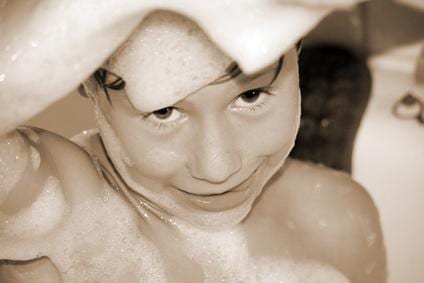Advertising for skin care products often promises to make your skin as soft as it was when you were a child. Any mother, however, can tell you that caring for a child’s skin has its pitfalls, too. From birth through adolescence, proper cleaning, hydration and nutrition are vital to keeping your kids’ skin healthy. Establishing a skin care routine and understanding common kids’ skin conditions will help you deal with all the special needs of your child’s skin.
Significance
Healthy skin functions in conjunction with your child’s immune, digestive and circulatory systems. It helps regulate his body temperature and keep him properly hydrated. It is his body’s first and most effective barrier to bacteria, parasites and other microbes that can seriously affect his health. Dry, damaged or unhealthy skin may make him uncomfortable and open the door to opportunistic infections.
Bathing
Nelson Novick, author of “Baby Skin: A Leading Dermatologist’s Guide to Infant and Childhood Skin Care,” advises parents to wash kids when they’re dirty, whether that’s three times a day or twice a week. He also echoes the common advice to use lukewarm–not hot–water, avoid harsh soaps, keep baths short and pat skin dry, rather than rubbing it vigorously.
Kids’ Skin Care Products
In a typical day, children come in contact with about 60 different personal care ingredients, says the Environmental Working Group, a consumer safety watchdog organization. On average, the group concluded, 27 of those ingredients have not been found safe for kids. The EWG has published a “Safety Guide to Children’s Personal Care Products” that details ingredients to avoid and recommends products that include only ingredients that are safe for your child’s skin. The report is available on EWG’s Skin Deep Cosmetics Database website.
Moisturizing
In general, kids’ skin will do fine without special moisturizing, Novick says. Environmental conditions, like air conditioning, heat, winter air and too much bathing, can dry skin out, though. If that happens, apply a moisturizer after bathing. Choose a product that contains both an oil-based emollient, such as petroleum jelly, to keep moisture in the skin, and a humectant, such as glycerin, to attract more moisture.
Wounds, Rashes and Skin Conditions
A break in the skin is an open pathway to infection. Follow basic first aid procedures if your kid cuts or scrapes her skin. Wash the area with gentle soap and water, smooth on a barrier ointment and cover with a bandage. Consult a doctor about rashes and other skin conditions, including eczema and contact dermatitis from poison ivy and other irritants.
Healthy Diet for Healthy Skin
A healthy diet is an essential part of your child’s skin care. Certain vitamins, specifically vitamin A, vitamin C and vitamin E, help his body make collagen, one of skin’s basic building blocks. Whole grains provide B-complex vitamins, which are another essential for keeping skin soft, healthy and clear. The best way to provide those nutrients is through a balanced diet that includes fresh fruits, whole grain cereals and breads, plenty of protein and healthy fats from nuts and vegetable oils.
Photo Credit
- Badetag image by Yvonne Bogdanski from Fotolia.com





